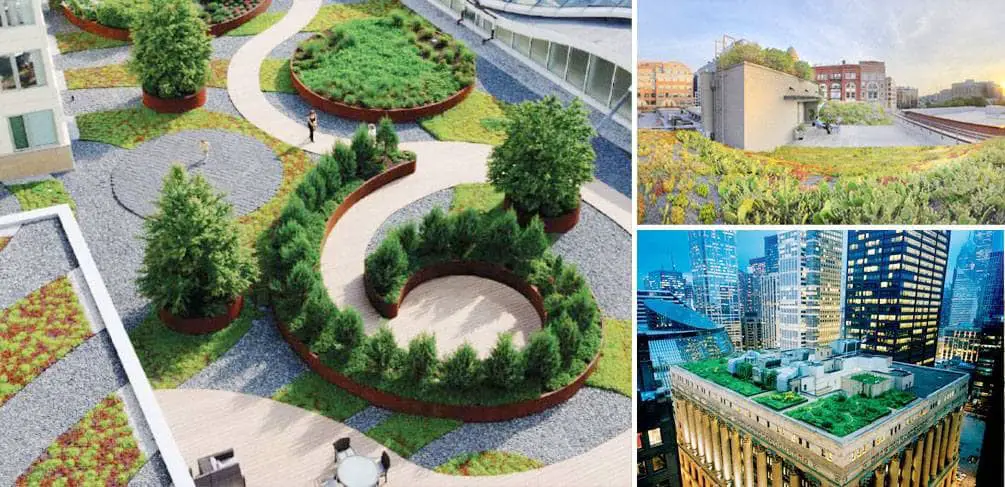In the quest for sustainability, innovative roof designs have become a pivotal aspect of modern architecture. These designs not only enhance the aesthetic appeal of homes but also contribute significantly to energy efficiency, environmental preservation, and overall home sustainability. Here, we delve into the top 10 innovative roof designs for sustainable homes that are making waves in the architectural world.
1. Green Roofs
Green roofs are perhaps the most popular among sustainable roof designs. These roofs are covered with vegetation and soil or a growing medium, planted over a waterproofing membrane. They offer numerous benefits, including:
- Energy efficiency: Green roofs provide natural insulation, reducing the need for artificial heating and cooling.
- Stormwater management: They absorb rainwater, reducing runoff and mitigating the risk of flooding.
- Biodiversity enhancement: These roofs create habitats for wildlife, promoting biodiversity in urban areas.
2. Solar Roof Tiles
Solar roof tiles integrate seamlessly into the design of the roof while generating renewable energy. Unlike traditional solar panels, these tiles are designed to look like conventional roofing materials, enhancing the aesthetic appeal of the home. Benefits include:
- Energy production: Solar tiles convert sunlight into electricity, reducing reliance on non-renewable energy sources.
- Durability: Made from tempered glass, these tiles are highly durable and long-lasting.
- Cost savings: Homeowners can save significantly on energy bills and may be eligible for tax incentives and rebates.
3. Cool Roofs
Cool roofs are designe to reflect more sunlight and absorb less heat than standard roofs. They achieve this through reflective coatings or the use of highly reflective materials. Key advantages include:
- Temperature regulation: By reflecting sunlight, cool roofs help keep buildings cooler, reducing the need for air conditioning.
- Energy efficiency: Lower indoor temperatures lead to reduced energy consumption and lower utility bills.
- Extended roof lifespan: Reduced heat absorption minimizes thermal expansion and contraction, prolonging the roof’s life.
4. Living Roofs
Living roofs, similar to green roofs, support a wide range of plant life. These roofs go a step further by incorporating water management systems, such as rainwater harvesting, to support the vegetation. Benefits include:
- Water conservation: Living roofs can capture and store rainwater, reducing the demand on municipal water supplies.
- Air quality improvement: The plants on living roofs can filter pollutants and improve urban air quality.
- Enhanced aesthetics: These roofs provide a beautiful, natural look that can significantly enhance the visual appeal of a home.
5. White Roofs
White roofs are painte with a highly reflective white coating that helps reduce heat absorption. This simple yet effective design offers several benefits:
- Energy savings: White roofs can significantly lower cooling costs by reflecting sunlight and reducing indoor temperatures.
- Environmental impact: By lowering energy consumption, white roofs contribute to the reduction of greenhouse gas emissions.
- Affordability: White roof coatings are relatively inexpensive and easy to apply, making them a cost-effective sustainable roofing solution.
6. Photovoltaic Roofs
Photovoltaic (PV) roofs incorporate solar cells directly into the roofing material. This innovative design allows homeowners to generate electricity from sunlight without the need for traditional solar panels. Key features include:
- Seamless integration: PV roofs blend seamlessly with the home’s architecture, maintaining its aesthetic appeal.
- Energy independence: Homeowners can produce their own electricity, reducing reliance on the grid.
- Scalability: PV roofing systems can be scale to meet the specific energy needs of the household.
7. Green Roof Modules
Green roof modules are pre-planted trays that can be easily install on a roof. These modular systems offer the benefits of traditional green roofs with added flexibility and ease of installation. Advantages include:
- Easy installation: The modular design allows for quick and easy installation, reducing labor costs and time.
- Flexibility: Modules can be arranged in various configurations to suit different roof shapes and sizes.
- Maintenance: Individual modules can be easily removed for maintenance or replacement, simplifying upkeep.
8. Bio-solar Roofs
Bio-solar roofs combine the benefits of green roofs and solar panels. This hybrid design allows for the simultaneous generation of renewable energy and the creation of green spaces. Benefits include:
- Dual functionality: Bio-solar roofs maximize the use of roof space by integrating vegetation and solar energy production.
- Improved efficiency: The cooling effect of the vegetation can enhance the efficiency of the solar panels.
- Environmental benefits: These roofs contribute to energy savings, biodiversity, and stormwater management.
9. Metal Roofs
Metal roofs are known for their durability, longevity, and recyclability. Modern metal roofs can be designe to reflect heat and improve energy efficiency. Key advantages include:
- Durability: Metal roofs can last up to 50 years or more with minimal maintenance.
- Energy efficiency: Reflective coatings and cool colors can reduce heat absorption, lowering cooling costs.
- Sustainability: Metal roofs are often made from recycled materials and can be fully recycled at the end of their life cycle.
10. Thatch Roofs
Thatch roofs are made from natural materials such as straw, reed, or palm leaves. While they have been use for centuries, modern thatch roofs incorporate sustainable practices and materials. Benefits include:
- Natural insulation: Thatch roofs provide excellent insulation, keeping homes cool in summer and warm in winter.
- Aesthetic appeal: The natural look of thatch roofs adds a unique and attractive element to any home.
- Sustainability: Thatch is a renewable resource, and modern thatching practices ensure sustainable harvesting and production.
In conclusion, the evolution of roof designs towards sustainability reflects the growing importance of environmental conservation and energy efficiency in modern architecture. These innovative designs not only enhance the aesthetic and functional aspects of homes but also contribute significantly to a more sustainable future.


